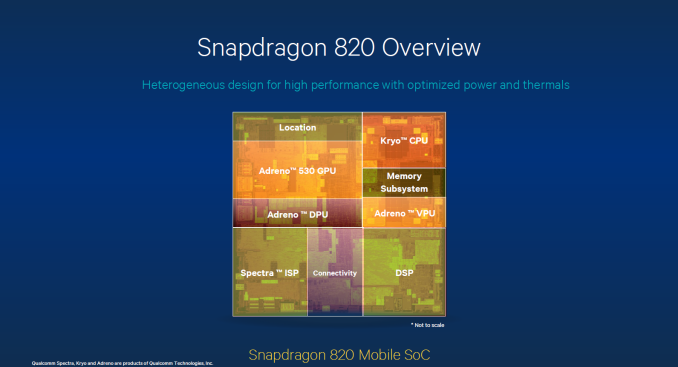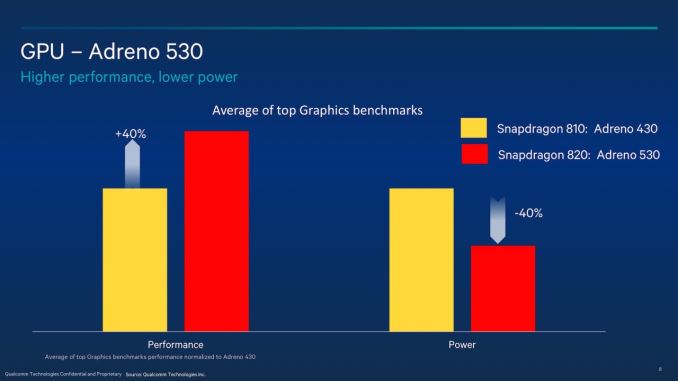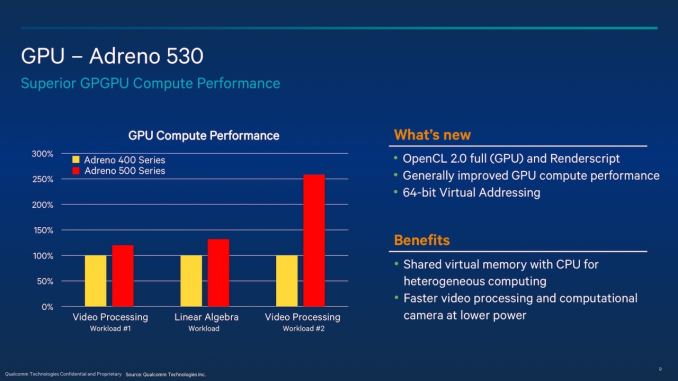Qualcomm Details the Adreno 530 GPU and ISP inside the Snapdragon 820
by Brandon Chester on August 12, 2015 9:35 AM EST- Posted in
- Smartphones
- Adreno
- Mobile
- Tablets
- Snapdragon 820

Snapdragon 820 is still a mystery as far as official information from Qualcomm goes. However, today Qualcomm has given a bit of insight into their upcoming SoC. While there's still no information about the CPU portion featuring Qualcomm's custom 64-bit cores known as 'Kryo', there are some details about the Adreno 510 and 530 GPUs, as well as Qualcomm's Spectra image signal processor.
Because Adreno 530 is their new flagship GPU, Qualcomm's press release focuses more on the 530 than the 510. The performance figures released by Qualcomm describe Adreno 530 as being 40% faster than Adreno 430 on average, while also consuming 40% less power. This result is described as an average of "the top graphics benchmarks", and while it's still generally a good idea to take vendor provided numbers with a grain of salt, if the power and performance gains over Adreno 430 are anywhere in the ballpark of Qualcomm's 40% figure then Adreno 530 should end up being quite impressive.
On the API side, Adreno 500 series GPUs will support OpenGL ES 3.1 + AEP (Android Extension Pack), Renderscript, Vulkan, and OpenCL 2.0. With OpenCL 2.0 comes support for Shared Virtual Memory (SVP), which allows an OpenCL host program and a device's kernel to share a virtual address space so access to data structures like lists and trees can be easily shared between the host and GPU. Adreno 530 has varying improvements to GPGPU performance when compared to Adreno 430, but Qualcomm's slides show video processing as demonstrating the greatest improvement with a 2.5x increase in compute performance. This is also the area where efficiency gains for generational improvements typically happen, so we expect fixed-function codec support although this information is not yet provided.
As for the ISP, it's still the case that mobile image signal processors are black boxes. Qualcomm is stating that their Spectra ISP in Snapdragon 820 will be able to support 3 simultaneous cameras at up to 25MP and at 30fps with no shutter lag. The Spectra ISP will also use MIPI's higher bandwidth C-PHY serial interface, which supports the enhanced camera support. As well as this, new developer and user-facing features include support and APIs for depth maps and using dual cameras to perform refocusing or other visual effects - because Qualcomm is just the SoC manufacturer, it is up to the smartphone OEMs to implement dual-camera/depth-maps as a feature as well.
According to Qualcomm, Snapdragon 820 will start showing up in devices during the first half of 2016. Hopefully between now and then there's more information from Qualcomm about the other aspects of their new SoC, including their Kryo custom CPU core. In Q1 we will be at Mobile World Congress, so we may see more information at that time.












66 Comments
View All Comments
syxbit - Wednesday, August 12, 2015 - link
Very disappointed if the SD820 really won't release until 2016.Just what will the 2015 Nexus 6 have? There just isn't a good SoC available.
SD810 sucks, SD808 is merely a compromise.
Tegra X-1 is too power hungry.
Exynos probably won't sell to non Samsung devices
TI is dead
Intel is, well Intel.
Mediatek doesn't have anything super high end (they have Helio X20, but it uses DDR3)
Rockchip is lower end.
Maybe SD620? But that's rumoured for the 2015 N5.... While the SD620 has a good CPU, it doesn't have the GPU for 2560*1440 :(
lilmoe - Wednesday, August 12, 2015 - link
"Exynos probably won't sell to non Samsung devices"Actually, they are. Meizu is not a customer.
"Tegra X-1 is too power hungry"
Don't give up on them just yet. They're still at 28nm... They might be featured in lots of Windows 10 Mobile tablets (and probably smartphones) in the future with 14/16nm SoCs with great GPUs. They have a very good advantage in Windows because of DX12. We should see the fruits of this in a couple of years.
lilmoe - Wednesday, August 12, 2015 - link
Meizu is *now a customer.syxbit - Wednesday, August 12, 2015 - link
The Tegra-X1 is 20nm. I know Nvidia has never done well in phones. They try to make the GPU too beefy, so they can boast in benchmarks, when in reality, the SoCs aren't in the same power envelope.As much as I like Nvidia, they're do some stupid things. Literally every year they compare against a 6 month old Apple Ax chip that is designed for phones/tablets. Yes Nvidia, your device is faster than an old chip that consumes half the power. Well done.....
I really wish Nvidia would try to get in to the phone/tablet market again.... It's telling that despite how awful Qualcomm has been this year, they're still shipping in a lot of phones..... A few years ago, a mistake like this would have meant lots of OEMs shipping with alternatives like TI/Nvidia
lilmoe - Wednesday, August 12, 2015 - link
The K1, which is actually used in mobile devices is on 28nm. The X1's TDP is at ~10W and isn't even sensible for tablets I believe.name99 - Wednesday, August 12, 2015 - link
Have nV given up on Denver?That web page
http://www.nvidia.com/page/products.html
is quite something. A perfect example of how to destroy your company by trying to do a hundred things badly rather than concentrating on doing one thing well.
And in all the hype (every processor page, whether it's X1, K1 or Tegra 4 is the greatest, most advanced, bestest smartest prettiest SoC in the history of humanity) nothing that I can see about Denver.
Way to go in supporting your own core, nV! How can you be surprised that no-one else is interested in using it when you apparently have no interest in promoting it?
Speedfriend - Thursday, August 13, 2015 - link
@syxbit'Intel is, well Intel'
What I am interested in, is what Intel does in mobile with its new 3D Xpoint memory. There have been some rumours that they will produce an SOC with eDRAM and 3D Xpoint, which will allow significant power savings when the device is sleeping due to the non-volatile nature of the 3D Xpoint.
Dobson123 - Wednesday, August 12, 2015 - link
There's a mistake in the article:"The performance figures released by Qualcomm describe Adreno 530 as being 40% faster than Adreno 420 on average, while also consuming 40% less power. This result is described as an average of "the top graphics benchmarks", and while it's still generally a good idea to take vendor provided numbers with a grain of salt, if the power and performance gains over Adreno 420 are anywhere in the ballpark of Qualcomm's 40% figure then Adreno 530 should end up being quite impressive."
They compare with Adreno 430, not 420.
allanmac - Wednesday, August 12, 2015 - link
Details? There are no details here.Rabbit_ear - Wednesday, August 12, 2015 - link
adreno 530 GPU can save 40% power compare to previous adreno 430 GPU but still deliver 40% more performance. http://androidmarvel.com/index.php/2015/08/12/snap...